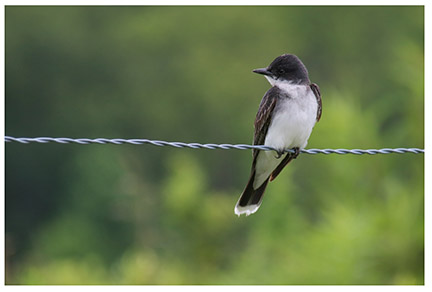

Heaven help any crow or hawk that approaches the kingbird's nest. Uttering a high pitched cry, the kindbird sets out in hot pursuit, swooping down again and again to strike its larger adversary on the back and shoulders. Finally it returns home in triumph with short, quivering wingbeats. Even humans who venture to climb to its nest are given the same unceremonious reception, and have been known to fall from a tree when taken aback by the fury of this starling sized bird's onslaught.
The Eastern Kingbird, Tyrannus tyrannus, is common in eastern North America during the summer; in winter, like other northern members of the family, it migrates to tropical climes where it can find insects (bees, ants, grasshoppers, beetles, etc.) on the wing. Later in the year they will also feed on berries. Grayish black above and white below, the kingbird has a white tipped tail, and on its crown is a concealed red patch. An appropriate crown for this tiny monarch of birds.
Eastern Kingbirds prefer farmland or open country with scattered trees, along roadsides and near water. The Kingbird nest is made of rootlets, grass, twine, hair, wool and lined with fine gass and moss. The nest is built on tree limbs, bushes, eaves, fence rails and bridges. The female lays 3 to 4 creamy white eggs, spotted with brown (1.0 x .7 inches). There is one brood per season. Incubation is from 16 to 18 days. Both parents care for the young, which fledge in 16 to 18 days. Parents continue to feed the young another 3 to 5 weeks after that.
This bird's range is along Canada's southern tier to the northern tier of the United States, southeastward. It winters in tropical climes.
Photo courtesy NPS




